No art: what a nightmare
by Johanna Ziebritzki
The following is a journey that we undertake in order to find out whatthe abilities of contemporary art are, and why it is that no one has ever been able to censor art to the point of extinction. The starting point for our journey is (1) Socrates’ ideal state, which we look to in order to understand the reasons behind censoring art. But because it is a purely theoreticalideal and we crave some real world experiences, we advance on the highway of reality. Stopping once in a while to rest, we take a look at (2) the use of art in totalitarian dictatorships and (3) the old worry that neoliberal systems disable true art. We surely do not want to settle down at one ofthe sights seen so far because they do not satisfy the interest that got us going. We take the exit that leads us to (4) Western Europe at the beginning of the 21st century and keep searching for an answer by simply interrogating that what is there and then presented as art.
1. No stories about tears allowed
To this day one of the bestknown concepts of an ideal society is Plato’s Republic1, which contains a dialogue between Socrates and his interlocutors, mainly Glaucon and Adeimantos. They come up with all kinds of evidence that a seemingly just but truly unjust person lives a better and happierlife than the truly just person. To prove that only the truly – and not the seemingly – just person is happy, Socrates undertakes to create and describean ideal state. He does so, because he believes it to be easier to answer such a tricky question if one searches for it by looking at something largerthan a single person. If the state as a whole is just, then every person in it has to be just as well. By inspecting the overall happiness of the ideally just state Socrates means to find evidence for his thesis.
Socrates begins the genesis of the state by stating that each person in it has an occupation according to his or her nature. People follow their natural talents as occupations, thus they are content with their work. To Socrates the division of labour is therefore a natural and easy way to satisfy needs. The state has to have a size at which labour is specified – no shoemaker would also want to make clothes – and everybody is occupied corresponding to her or his natural talent.
One main theme in the drafting of the state is education and the reign of the guardians of the state. Socrates describes how children are to be brought up communally and strictly according to state order. The guardians reign wisely in order to preserve the just state. In order to find children suitable to become guardians and, once found, enable them to be preoccupied exclusively with guarding, the lives of the guardians are arranged in a certain way : They are not allowed to have personal possessions, which suspends them from having a family. Furthermore the guardians live and eat communally and are forbidden to handle gold or silver. The community of the state provides shelter and food for the guardians, not in abundance but always sufficient. In return the guardians provide the stability of the given just situation.
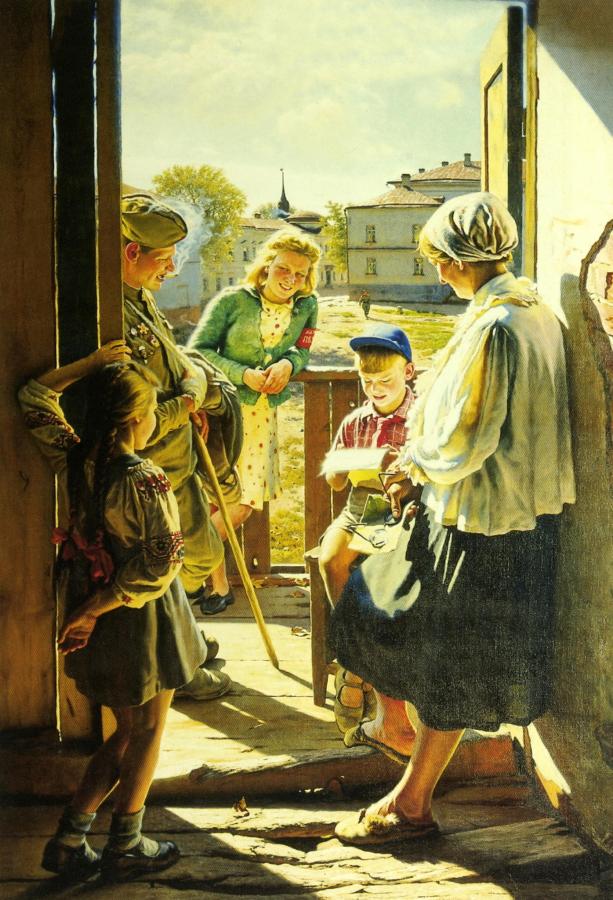
Alexandr I. Laktionov: Letter from the Front (1947).
Socrates explains that guardians have to be by nature exceptionally capable philosophers as well as statesmen, while maintaining a keen balance of certain virtues. Only very few have such nature. Both men and women can have the right nature. Thus, Socrates argues to the astonish ment of the interlocutors, women and men have to be brought up together and equally. Only that way would be feasible to find all the children naturally suited to become philosopher-statesmen.
The overall goal of the ideal state is for all the people in it to be equally happy. Therefore pursuing individual happiness – or what seems like it – is not supported. Neither is the accumulation of honor, power or wealth of a few on the cost of the many. Only when many work together as one is the state the ideally just state.
‹For the victory which they [the guardians ; JZ] have won is the salvation of the whole State ; and the crown with which they and their children are crowned is the fullness of all that life needs.› (466d)
Socrates drafts the ideal state ‹with a view to the greatest happiness, not of any particular class, but of the whole› (466b). In order for the people of the state to be equally happy, it has to be led by guardians, that know what is good and what is bad with certainty. Guardians that arte infallible in their values, judgements and decisions. Drafting the state therefor meansto create a setting in which it is possible to view the idea of good : The idea of good depicts for Socrates the one, ultimate insight in what is good. Therefor the person to whom the idea of good is revealed is able to understand truth, justice, felicity, beauty and all virtues in the light of the way they are good. Philosophical questions, like the one that sparked the dialogue about the connection between happiness and justice, could be answered rightfully only by a person who has seen the idea of good.
‹For you have of been told that the idea of good is the highest knowledge, and that all other things become useful and advantageous only by their use of this. You can hardly be ignorant that of this I was about to speak, concerning which, as you have often heard me say, we know so little; and, without which, any other knowledge or possession of any kind will profit us nothing. Do you think that the possession of all other things is of any value if we do not possess the good?› (505a)
Plato presents through Socrates the believe in absolute ideas, which exist external to and independent of the sensual and material realityof the people. Since Socrates believes in the idea of good as absolute – and intellectually elusive – he models an ideal state in which the best may actually reach the idea of good. In the state the education and upbringing of the guardians leads them to seeing the idea of good and furthermore enable them to apply their insight by reigning with the gained wisdom truly just. Seeing the idea of good requires highest reason because ideas can not be un derstood through studying their copied images that exist on earth. Being involved in earthly material too deeply is not conducive to seeing the idea of good. Hence the philosopher who aims for it should not feel strong emotions that manifest themselves for example in loud laughter or wails. Only the strongest and clearest minds lead by pure reason are eligible for the task.
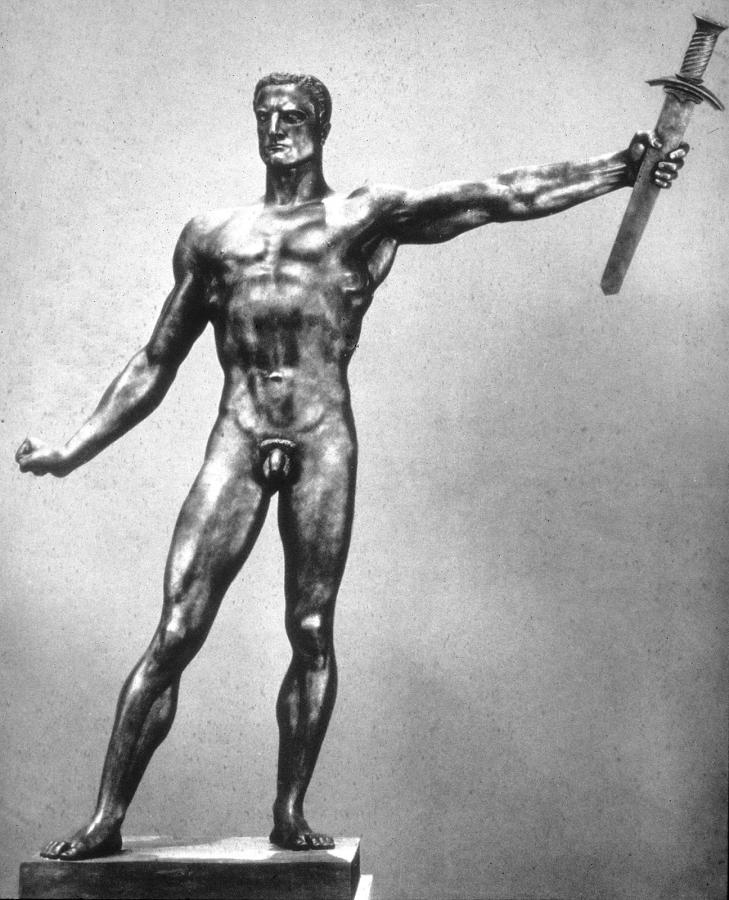
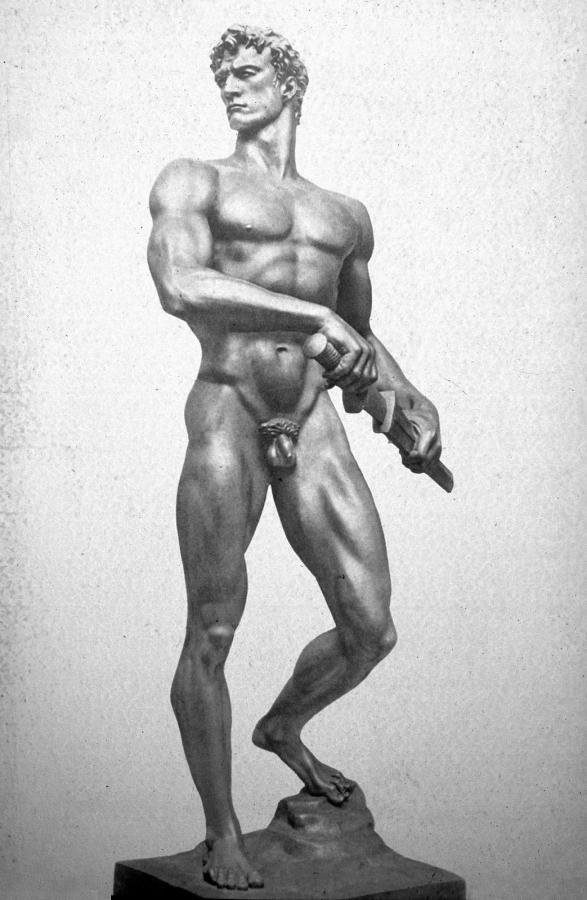
Arno Breker. Links: Die Wehrmacht (1935). Rechts: Bereitschaft (1939).
Poets, as Socrates understands them, are not lead by the idea of good as they create. On the contrary, their stories are about fighting, envy, adultery and lust. People who hear these stories, get wrong conceptions of the virtues and thus long for what is wrong. The stories of the poets, Socrates declares, do not help in any way to build a truly just state.
To ensure the stability of the ideal state, nothing else but what backs it up, can be voiced within it. That hits the poets hard. Those who write or sing poems with contents that are not in line with the doctrine of the state are either exiled or, if already dead, severely censored.
‹Socrates: And shall we just carelessly allow children to hear any casual tales which may be devised by casual persons, and to receive into their minds ideas for the most part the very opposite of those which we should wish them to have when they are grown up?
Adeimantos: We cannot.
Socrates: Then the first thing will be to establish a censorship of the writers of fiction, and let the censors receive any tale of fiction which is good, and reject the bad; and we will desire mothers and nurses to tell their children the authorised ones only. Let them fashion the mind with such tales, even more fondly than they mould the body with their hands ; but most of those which are now in use must be discarded.› (377c)
In order to not let ‹wrong› ideas enter the minds of the young citizens censorship is installed. Because if the state is lead by philosopher-statesmen who reign according to the idea of good, no other stories or values can aug ment the goodness of the state. Glaucon raises the question, if and if so how it is possible to realize the ideal society. Socrates states that it would be quiet a hard task.
‹Socrates: Well, and were we not creating an ideal of a perfect State?
Glaucon: To be sure.
Socrates: And is our theory a worse theory because we are unable to prove the possibility of a city being ordered in the manner described?
Glaucon: Surely not.› (472e)
Even though the actualization of the ideal society may be impossible, Socrates nonetheless believes in the rightness of his theory while at the same time he states that the actual state will not ‹in every respect coincide with the ideal› (473a).
Plato as a philosopher, who records with the Republic the discourse and explanations of his teacher Socrates, drafts an ideal just state based upon the knowledge of the good that is only reachable by pure reason. The sung and spoken poems on contrary are not depicting a perfect world: They depict strong leaders wailing, happy people founding their happiness on material wealth, gods cheating on their partners and fighting. Art tells stories about the weak, about the unjust, the otherness, the uprising against common conventions, about inequality, about rebellion, about tears,about joy. Because humans – as long as not having seen the idea of good – are fallible.
2. Ideal or Ideology
The concept of eliminating the freedom of speech and expression became a common feature of dictatorships. In these, censorship served and serves the same purpose for which Socrates installed it: not to let other thoughts enter the minds of the people than those officially preached. But Socrates’ ideal state and that of real dictatorships differ widely regarding the overall goal that is aimed at and to which censoring is only one of many steps. Socrates drafts a truly just state in which all people are equally happy, because their wise leaders truly know what is good.
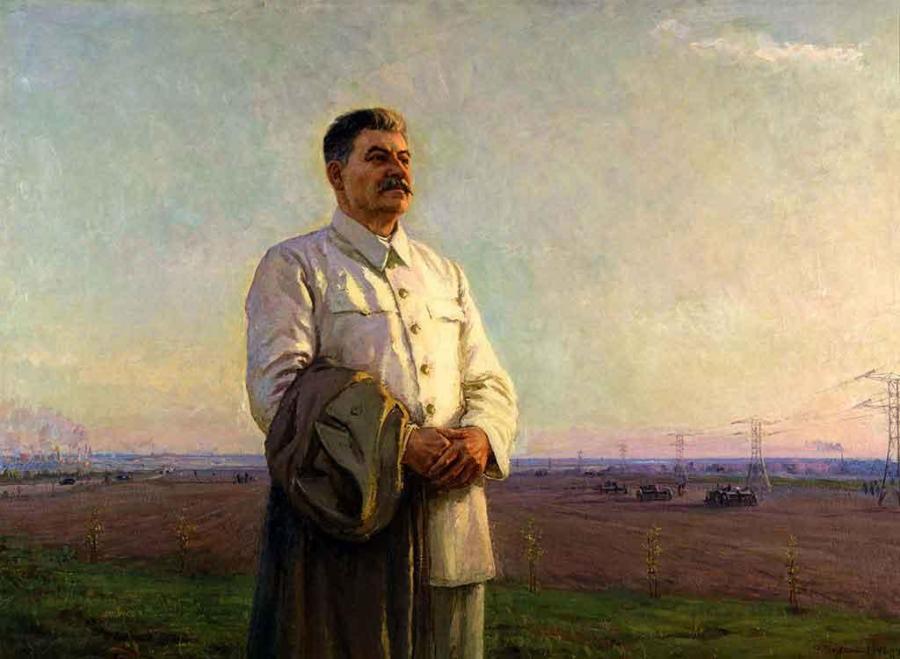
Fjodor S. Schurpin: Dawn of our nation (1946) [translation by J.Z.].
Dictators in the last century propagated that their state was to be better than any past state for all humans in it. But the propagated did not coincide with reality. The promise brought more death than joy, since ‹human› became an exclusive category and furthermore only those humans, that lived in line with state order, were benefitting or sometimes merely left alive. In these systems ‹art› had to prop up the ideology. The freedom of expression was eliminated, which was not only deadly for the arts. The simple human longing for love, care and trust, that can only be stilled if equality and freedom of speech are given, was suppressed, since the status of being an adequate human was denied many people. Art and humanness were killed with one stone.
Alexandr I. Laktionov (1910 –1972): famous painter of social realism in UdSSR. The painting above Letter from the Front (1947) celebrates the end of the Second World War with the victory over Germany. 1948 Laktionov received the StalinPrize First Class for the painting. He portrayed many important figures of the StalinRegime and propagates in his paintings patriotism and optimism.
Fjodor S. Schurpin (1904 –1972): euphemized with his paintingof Stalin entitled Der Morgen unseres Vaterlandes (1948) the situation of the country that was still warravaged and struggling with infrastructure, food supply and housing. In 1948 Schurpin received the StalinPrice Second Class for his painting.
Arno Breker (1900–1991): artist that came to glory during under Hitler’s regime. He received many remittance works and his sculptures ornamented many official public buildings and places just as he portrayed the leadership. In 1940 he was the first German artist to receive the MussoliniPrice of the Venice Biennial. He was not only on Hitler’s list if the ‹Divine Artists›, but also one of the twelve ‹Irreplaceable Artists›. In the trials after the end of the war Breker was considered a follower.
Of course these three figures are more complex than depicted now. Breker for example was exempt from having to go to war by being on the list of the ‹Divine Artists›. But whatever facts might unburden the named artist from the accusation of playing an active role in a brutal dictatorship – they nevertheless commissioned their artistic production to the ambition of these.
3. Fallibility
There has never been an ideal society that was acknowledged by all in it as such. Maybe that is because people are too diverse and have different urging needs. Not even a completely standardized upbringing can erase some personal needs without violence, as history and actual worldwide events show.
The contemporary term of ‹art› is ambiguous and, even though it is much discussed in theory, it is not conclusive definable. It is home to many heterogeneous, even mutually exclusive concepts, practices and products. But all these diverse heterogeneous ‹X›s that are subjected to art have one common denominator that I emphasize now and will refer to in the following: as art they have the possibility to differ in the manner of handling value, speed, necessity, utility et cetera from the currently ruling principle of neoliberalistic production and consumption.
If, and only if, each person in Socrates state would be truly happy, and if the state would be truly just due to its wise guardians which reign according to the idea of good, art is really not needed any more. The people living in the ideal state itself, as I understand it, have no need to produce and no longing to perceive ‹art›. Thus banning and censoring the poets that disseminate wrong values and morals is a necessary regulation in order to let the idea of good spread until the ideal state is erected. Can art in this day and age thus be understood as a feature of a nonideal state, a state that is lead by fallible humans and not by the idea of good? Does art flourish where the basic needs are satisfied and humans have the time to reflect upon themselves and themselves in relation to their surrounding? Is art the quest of humans that struggle to be what they assume they – as humans – should and could be? Art understood in this manner is a place in which being human is negotiated – in which humanness again and again can be attempted, be inspected, be declared an illusion, be declared dead, be revived, be celebrated.
We do not live in an ideal state. Humans are fallible, that is a sufficient explanation. Since we do not have the idea of good, we struggle and stumble and sometimes get lost while trying to be what we learned we are: human. Being a good human is even a harder task, because we don’t posse the absolute idea of good but only have vague ideas. This effort to be a good human, the struggle for the unreachable ideal, is what I call Menschlichkeit. To put it simple: Menschlichkeit is the negotiation of humans about what it means to be a good human. Being a good human might imply: care, love, engagement, attentiveness, sincerity, equality and respect for the ungraspable other while being aware of ones own fallibility and ones own relativity.
4. Negotiating Menschlichkeit
Art withholds the possibility to act, create, think, produce, comport oneself differently from the ‹normalcy› that is shaped by social, political, economic and other conventions. What forces drive artists to realize one idea andlet another vanish undeveloped on the harddrive? What impact do artworks have on people?
For some people who are creating or producing art it withholds the possibility to raise doubts about the existing balance of power and to come up with counterhegemonies. Since I am not them, I am unable to get to the bottom of the true motives which are the genesis of these artworks. From my position I can only hazard. But since I have seen certain artworks that deal with the question about what it means to be human, I switch to the side of the reception.
Aesthetic experiences can give way to doubts, or universal love, or total diffusion, or happiness, or being one whole, or hatred – but whatever is feltthought thereby is part of the artistic sphere. By being an experience distinct from everyday life, the feltthought does not lead to immediate activism, but primarily to reflection – that again can very well result in action, but just as well not result in anything graspable.
Many of us involved in the arts and philosophy are aware of the ever growing and all controlling neoliberal principles of ‹work hard, gain much›. Of course the neoliberal system exploits humans in order to make the capital grow. And yes, especially we who are part of the creative industry have internalized the efficiency principal and yes, we are well adapted. We don’t receive social benefits from our employee, since we are freelancing. We are too busy with our next supposedly mindblowing project to slow down, to think critically about the system we live in and critically about our critical thinking. And who knows if that could even stop exploitation, stop the instrumentalization of humans. Who really knows if doublereflection would make any change towards the better. Even if cultural products are debunked as the product of internalised neoliberal principals which disguise themselves as not coming from exactly these principals – that knowledge can not reverse the incredible, multilayered and rich experiences that simply touched my heart and blew my mind, which I have had with certain artworks. Even if the concern that all art is merely a commodity of the cultural industry has been raised by many and often – the experiences with art provethe opposite: artworks with the potential to give way to an experience which cannot be commodified and which is specific to art do exist. Now what kind of experience is that? Instead of trying to explain generally how such an experience is structured, I will simply give an example. I choose the most recent of such experiences:
Riding on a cloud by the lebanese artist and director Rhabi Mroué tells the story of Yasser Mroué, his brother. We learn that at the age of 17 Yasser got shot in the left side of his head. He had heard on the radio that his communist grandfather was assassinated. It was while he rushed tothe house of his grandfather that a sniper shot him. Yasser Mroué survives but looses many abilities, among them the ability to recognize representations as such. All he sees in a photo is color on a paper. His doctor advised him to use a camera in order to learn to recognize representations correctly. Many little films evolve. Some of the films are part of the play as well as some tapes that are recorded and played on stage. Yasser Mroué tells pieces of stories about Yasser, about the process of the evolution of the play withhis brother Rhabi and about his family. His arabic words are subtitled onthe screen that occupies the middle of the stage. Yasser himself is seated behind a desk on the left side of the stage. To his left side is a DVD-player in which he puts the movies, each movie is on its own CD all piled neatly next to the DVD-player. To his left is the taperecorder and a pile of tapes. He thematizes his story, but as a play it is the story of a lebanese man who gotshot, who survived, who recites poems, struggles, has sex, sings communist songs he remembers from early childhood and plays guitar with his brother. The play does not circle topics like guilt and resentfulness. Yasser Mroué, who has trouble with representations, is the sole and main actor of a play, in which he is himself but at the same time he plays the Yasser that was const ructed for Riding on a cloud. The play is complex and has many layers while at the same time it is moving, beautiful, sensual. It is the result of a highly reflected artistic position. The aesthetic experience it enables is not a simple sensualhappywhole feeling, but highly demanding on the one side and simply touching in the way of not fully understandable, not fully explainable on the other side.
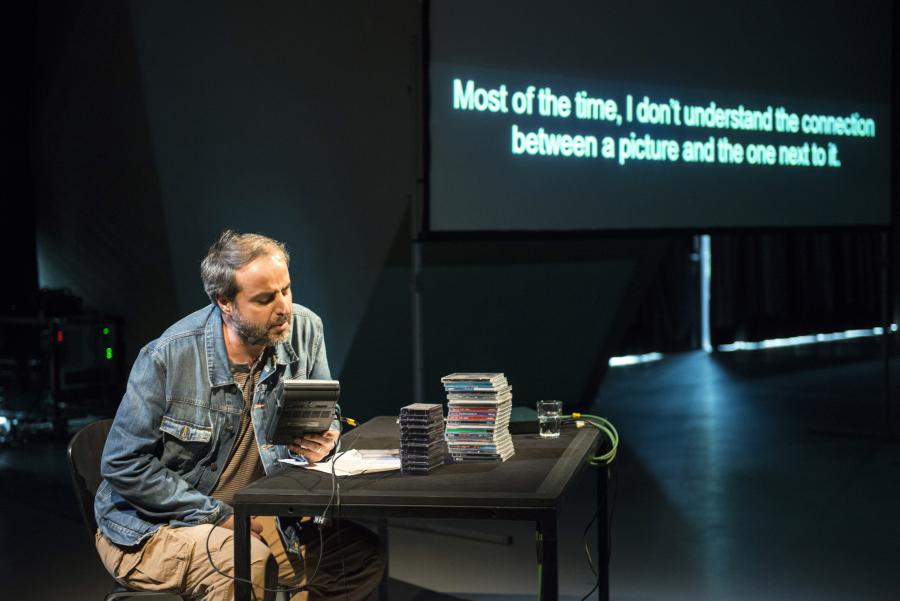
Yasser Mroué in Riding on a cloud by Rhabi Mroué, © Marcus Lieberenz / Haus der Kulturen der Welt.
When art makes me shiver, makes me rethink, makes me wonder or makes me weak, then it is truly powerful, because in such moments art reveals the fragile, stumbling, fallible human while at the same time the believe in the notion of Menschlichkeit is present. In some artworks the tiring and absurd, but also beautiful and charming effort of humans struggling for Menschlichkeit becomes graspable. Nope, we don’t know onceand for all what a truly just life in a perfect state would be like. Quiet on the contrary is the world far from a situation that we could even call ‹good› for the majority of humans. Socrates was quiet aware of the complications that the actualization of the ideal state would bring about, but he nevertheless found it necessary to draft it : to spread his understanding of what is good anyway. 2500 years of human struggling have passed and humans still try to figure out what Menschlichkeit is. Art is the main field of this negotiation, because art holds the crucial potential: the possibility to differ from the norm.
- 1. Plato : Republic. For english text see : http://classics.mit.edu/Plato/republic.html, query : 16.01.2015.